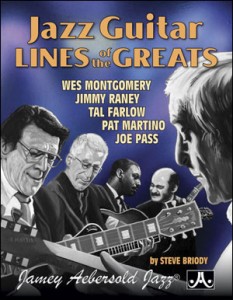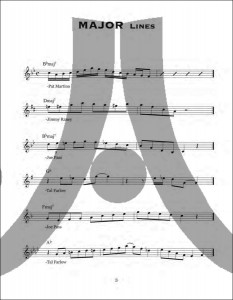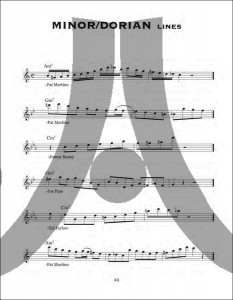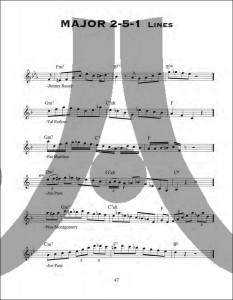Jazz Guitar Lines Of The Greats by Steve Briody is a large compilation of 675 jazz lines written for reference, learning, and expanding one’s jazz vocabulary. Taken from the works of Joe Pass, Jimmy Raney, Tal Farlow, Wes Montgomery, and Pat Martino, the lines are meant to inspire jazz musicians at any level.
The use of imitation has been used throughout the entire history of music. In fact, before the introduction of copyright laws, taking an excerpt from another musicians’ composition or work and implementing it into your own music was not considered “stealing” or a “shortcut,” but was a way of honoring musicians you revered and aspired to be like.
Now, is this book encouraging being a carbon copy of some of these players? Absolutely not. Even if you were to take these lines, or even a wholly transcribed piece by any jazz musician, and played it yourself, you would still sound like yourself! As Steve Briody says in his introduction;
Work these new ideas and phrases into your own playing. Don’t worry that you may become a “clone.” Remember that each of us learned to speak through the means of imitating our parents and siblings — do you speak exactly like them now? Of course not. Wes Montgomery, Barney Kessell, Tal Farlow and many other greats were eventually able to develop their individual styles after learning all of Charlie Christian’s solos and licks. Learn the phrases of your favorite jazz players, get experience playing in jazz groups whenever you can, and your own style will certainly emerge over time.
One of the reasons I named this post “Lines Of The Greats” rather than using the title, “Jazz Guitar Lines Of The Greats” is because these lines are applicable on any instrument. Randy Brecker says, “Steve Briody’s ‘Jazz Guitar Lines Of The Greats’ is a great reference book for any instrument – a lot of these lines lay quite well on the trumpet and are a great way to expand one’s jazz vocabulary!” Within reason, music is fairly transferable to most instruments
This compilation is broken up into five chapters, each with its own selection of musical gems. Chapter 1 covers Major lines, chapter 2 covers Minor/Dorian lines, chapter 3 discusses lines than can be used over Major 2-5-1 chord progressions, chapter 4 discusses lines that can be used over Minor 2-5-1 chord progressions, and chapter 5 wraps up with Dominant 7th lines.
Legends such as Pat Metheny and George Benson have referred to jazz as a “language,” consisting of its own grammar and syntax. This book provides the guitarist with a substantial amount of “vocabulary words,” and it was a great deal of fun for me, as well as an amazing learning experience, to transcribe and categorize them.
Example of Major lines
Example of Minor Lines
Example of Major 2-5-1 lines
As you can see from the examples above, the format is pretty simple. Generally 2-4 bar phrases, in standard notation, with the chords the lines go well with written above the staff, with the originating artist credited for their musical lines.
I’ve played through quite a few of these lines, using some of the Aebersold play-a-long tracks, and with the AmpliTube iRig for my phone (Review coming soon!), where I would record myself playing the chords, play it back, and use some of the guitar lines over them. To say there is an overwhelming amount of information for me would be a slight misrepresentation. In keeping with the language and vocabulary analogy, we’ll call this book a dictionary. It’s like I picked up a small dictionary, with a whole bunch of “words” that I wanted to learn, with a very small starting vocabulary. So, I figured that I would use this book like a jazz lines dictionary. I’ll use it to learn new “words” and look up new “words” when I want to use them! Say you were learning a tune, and needed a great line for a specific chord, or chord progression. You could use this book to look up a great line to “quote” or even just to give you ideas to craft your own line.
This book showcases the chops of many of jazz’s great guitar players and improvisors. I’m glad to have this book in my musical library to study and reference at any time!



